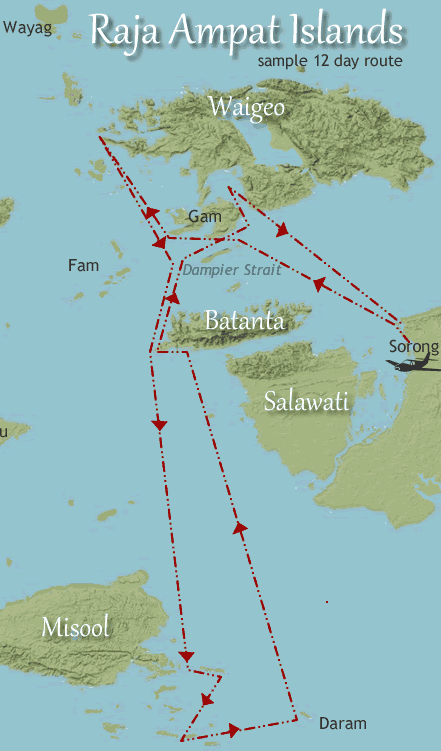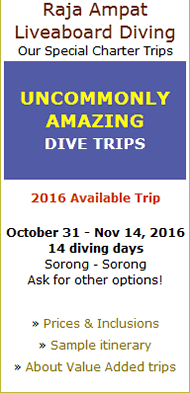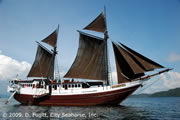NOTE: Congestion in Dampier Strait is now quite high due to so many resorts & homestays in the area, and short 6-10 day budget liveaboard trips that cannot reach far from Sorong. This congestion negatively impacts the quality of diving in that area. Ffuture City Seahorse trip itineraries will avoid this area except for some special rarely-visted unique sites and the Manta Ray dive. We will instead spend our trips diving the still pristine, uncrowded dive areas away from the mass of resorts. Sample itinerary will be updated soon. We altered itineraries in recent years - very successful trips - and rarely shared a dive site with other divers.
This itinerary is a sample. the actual itinerary will be similar but will vary with conditions during each trip. Strength and direction of current, weather, visibility and the wishes of divers aboard will alter each cruise to make it the best possible at the time.
 |
Sample Raja Ampat Liveaboard Itinerary
Sorong - Sorong Route = more options,
more diving, very few long cruises |
Day 1: Depart Sorong, Check Out Dives & Night Dive
Sorong, Bird's Head Peninsula, Papua Barat, Indonesia
9:00am board ship, unpack, assemble dive and camera/video equipment, lunch. Join your team of 2 or 3 other divers and your guide for 1-2 check out dives near Sorong. These dives are in calm water to facilitate organizing proper weight & both dive and camera equipment.
On these first dives you will likely see baby Wobbegong Sharks the length of your outstretched palm, flasher wrasse, frogfish, multiple species of anemonefish, nudibranchs, sea pens, stonefish, lionfish, bommies covered with crinoids & glass fish and small to medium schools of fish.
On the 6:30pm night dive your guide will find a myriad of night critters including snake eels, porcelain crabs, decorator crabs, sea pens, Spanish dancers, octopus, and squadrons of squid for you. After midnight cruise the 6 hours to Raja Ampat.
Day 2: Fishes And Reef Diving
Dampier Strait, Kri / Waigeo / Gam Islands
Coffee and light breakfast available 6:00am followed by your first dive in Raja Ampat. This morning we choose an easy dive site with ribbons of yellow four-lined snappers draped across a sloping reef studded with bommies covered with red, pink, yellow and orange soft corals.
First time visitors to Raja Ampat will be amazed by the variety of fish species on this first dive. There are pygmy seahorses, nudibranchs, pipefish and small gobies to be examined closely. Make photos hovering over a giant clam nearly as wide as a diver can reach. Your guide will check the white sand and under ledges for Wobbegong sharks!
After a "big" breakfast, dive another site 30 min. cruise away. All sites in this area are very fishy and colorful. After lunch 2 afternoon dives are offered. Enjoy the sunset from a lounge chair on the ship's top deck. The night dive starts at 6:30pm followed by dinner and a collapse into the berth of your air conditioned cabin.
Spend the night at anchor in a sheltered spot near the dive sites.
Day 3: Hornbills, Fishes, Reefs & Walking Sharks
Dampier Strait
Awake at dawn if you like to grab a cup of steaming coffee and sit on the ship's bow to enjoy the sound of bird calls. Hornbills, cockatoos, parrots, sea eagles are very active in the morning.
There are many dive sites in this area. We repeat our daily "schedule" adapting to the direction and strength of current. Each site has something unique to offer. We may choose to dive a site with a huge school of jacks, a site with an large overhang and boulders where hundreds of yellow sweetlips congregate and the top is often filled with swirling clouds of blue fusiliers and surgeonfishes.
At 6:30pm prepare for one of the favorite dives for both photo and video. Follow your guide on a shallow muck night dive to see Walking Sharks (Raja Ampat Epaulette Shark), a shark the size of your arm that "walks" on its fins across the sandy sea floor. You can also expect to see Wobbegong Sharks feeding on crustaceans in the sand, lionfish that hunt with your dive light, shy toad fish that croak so loud the vibrations tickle your feet, odd octopus species (sometimes blue ring or hairy), feeding cuttlefish, often seahorses and pipefish, lobsters and more. We never know exactly what we will find on this dive.
Emerge to a serenade by the children from the village who were sitting on the pier to watch the divers. Spend the night at anchor in a sheltered area.
Day 4: Passage Diving - Reef And Rainforest
Kaboi Bay
Be sure to arise early to experience the ship's slow entry into the maze of rock islands where we anchor for most of today. Your dive site is a narrow channel between two large islands used as a shortcut for local boats and sea gypsies, entire families who live on a raft.
Typical depth for a dive is less than 20 feet. The rain forest hangs over the passage creating unusual conditions where red soft corals, yellow cup corals and peach colored sea fans grow almost out of the water. This is the place to see Archerfish hunt insects shooting them down from the trees with water droplets from their specialized mouths. Sun rays through the trees create eerie lighting as we search for odd and beautiful nudibranchs (often with their egg ribbons and watch the unending work of the shrimp gobies. Long nosed butterflyfishes and billions of colorful sea squirts inhabit the shallows. Sometimes we see turtles, sharks and large bumphead parrotfish out in the channel. If you like, take a ride with our local guide Mikel through the rock island maze.
Return to the Dampier Strait for late afternoon and night dives. Overnight cruise.
Day 5: Vertical Muck Diving
Waigeo
We arrive this AM at our dive site for our first "open deck" day. Dive today as much as you like, when you like! Our dive site is a long stretch of wall along one side of a very deep bay where you will see many small critters and often clouds of silversides near the surface.
Things to see here include: mating pygmy cuttlefish, many different species of nudibranchs often including the large solar powered nudie, pipefishes (ghost, robust, winged, banded and more), lionfish, allied cowries in the soft corals, pygmy seahorses, devil scorpionfish, electric clams.. really this is a critter lovers paradise with too much to name. Sometimes the group loves it so much we stay two days. Dive all day including a night dive. Short overnight cruise.
Day 6: Manta Rays & Pier Dives
Papua Barat / Raja Ampat, Indonesia
Another of the favorite spots. 3M (Mantas, Mantis Shrimps and sea Moths) is foremost a manta cleaning station. We kneel in the sand and wait for large mantas to circle the rocks where they are cleaned by small wrasse. Mantas circle overhead, often within touching distance. If we don't touch or chase them they may stay around for hours.
This site also has many small creatures. We've photographed Flamboyant Cuttlefish, Pegasus Sea Moths, Skeleton Shrimp, the Pontohi Pygmy Seahorse (discovered in 2008) here. There are always many Spinecheek Anemonefish, shrimp gobies, garden eels and bommies covered with glassfishes as well.
After 2 morning dives, move an hour to a pier where soft coral encrusted pier pilings and schools of juvenile batfish make for great scenes of wide angle photos. Crab-eyed gobies, beautifully colored scorpionfish, gardens of giant clams round out today's dive menu. We often make at least part of this day "open deck". Overnight long cruise south, or, we may insert a "Guests' Choice" day of muck diving for Day 7 and stay for a night dive at the pier.
Day 7: Nudibranchs, Corals & Crabs
Northwest Misool
Arriving in the Northeast of Misool our first dive is a wall covered with short soft corals, large sea fans and cup corals. Typically we find many species of nudibranchs here during the day. At night the site is covered in brilliant yellow and orange cup corals and so many crabs it is impossible for you guide to show them all to you! We will dive here in the morning and again for the night dive.
In the sunny hours of the day we dive around a group of rock islands and pinnacles. Schooling fishes surround rugged areas covered with pristine soft corals. We may see swimming Wobbegong sharks, black tip sharks and large schools of batfish, surgeonfish, barracuda, fusiliers and snappers here. Short night cruise south.
Day 8 & 9: Colorful Corals & Fishes - Photographers Delight
Southwest Misool
Our dive guides favorite! This area contains multiple dive sites, some so huge we can spend an entire day without covering the same area twice. The reefs have such a diversity of life and color it would be easy to spend many days on just one reef. Sometimes gigantic schools of silversides flow over the reef in tornado shapes while hunting jacks launch themselves into the school to grab a bite.
Corals cover the reefs in shades that outdo the rainbow, pink, red, orange, peach, yellow, white, rust colors in soft corals, fans & black corals. Drop down deeper to find schools of larger fish, Napoleon and Maori wrasse, midnight snappers. One of the highlights is a valley of bright pink/red anemones inhabited by 2 species of anemone fishes. Many species of reef fish chase through the shallows while on the edges of the reef you may see eagle rays, mobula rays and sharks.
There are also small critters here like the bright red pygmy seahorse with white spots, sawtooth shrimps in the black corals, nudibranchs, lionfishes and ghost pipefish. Tell your guide what you want to see.
This is normally an "open deck" day although we may move the ship during the day when all divers are aboard. Tonight at anchor, probably near our night dive spot.
Day 10: Pristine Corals, Swim Throughs, Pinnacles
Daram
Overnight we headed northwest to a group of islands rarely dived. Both the soft and hard corals here are fantastic and you will see as you explore with your guide around underwater pinnacles, rock islands and sandy slopes.
At the end of the day we move to repeat one of our favorite night dives where we know we'll see many nudibranchs and silly decorator crabs and hope to find the walking shark on the reef's top. Longish overnight cruise north.
Day 11: Muck's Weird Black Sand Critters
Batanta
What is muck diving? Diving sandy, silty slopes of black sand that are home to many odd creatures. During this "open deck" day your guide helps you look for Mimic Octopus and the Wonderpus. Typically we find many ghost pipefish, unusual nudibranchs, anemonefish that live in sandy areas, snake eels, tiny cuttlefish, crinoids that house squat lobsters and shrimps, fire urchins which may have Coleman shrimp living upon them, shrimp gobies, upside down jellyfish.. more!
At night you may see the incredible Bobbit worms, many crabs & shrimps, night octopus. We never know what to expect at these sites, but it is always amazing. Overnight move just a few hours north.
Day 12 & 13: Guest's Choice
????
These two extra days will be spent according to the likes & dislikes of the guests aboard the trip. We might choose to revisit one of the favorite "HOT" sites, try a different site that we know will suit the guests, or a new one we've not dived ourselves but comes recommended by the ship's regular divemasters. These won't necessarily be on days 12 & 13, but will be inserted when our journey takes us near the desired site.
Day 14: Final Diving Day
Dampier Strait
For our last day of diving we must head back toward Sorong. Today we can dive 2-3 dives in the morning. Guests can choose whether we go back for more time with the manta rays, or finish up with some of the spectacular fishy reef dives in Dampier Strait.
After diving rinse gear and it dries while we have lunch and head back toward Sorong. Tonight enjoy the sunset while underway. Dinner on the ship in Sorong Harbor followed by a show and casual photo contest of our guests' photos and video.
Day 15: Departure
Sorong, Papua Barat / Raja Ampat, Indonesia Light breakfast, This morning you are shuttled to the airport in time for your departing flight. The crew will take your bags early and handle check in for you. You do not need to spend much time in the hot, smoky Sorong airport. |



